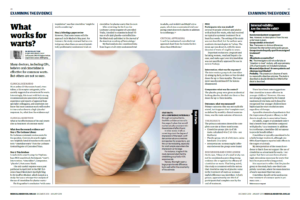Journal reference: Yilmaz E, Alpsoy E, Basaran E. Cimetidine therapy for warts: a placebo-controlled, double-blind study. J Am Acad Dermatol 1996 Jun;34(6):1005-7
Link: https://doi.org/10.1016/S0190-9622(96)90279-0
Published: June 1996
 Evidence cookie says… |
The limited research evidence does not support the use of oral cimetidine as the treatment of common warts
|
 This article was published in the December 2018 / January 2019 issue of Medical Observer under the title “What works for warts?” (PDF)
This article was published in the December 2018 / January 2019 issue of Medical Observer under the title “What works for warts?” (PDF)
Clinical scenario
On an online GP discussion board, cimetidine, a H2-receptor antagonist, is frequently suggested as a treatment for warts. Interestingly, this is met with both strong recommendations (anecdotes of personal experience and reports of approval from specialist colleagues), and scepticism – we know that most common warts will resolve in time and so there is a high “placebo” response. So, what is the evidence?
Clinical question
What is the effectiveness of the oral cimetidine as treatment of common warts?
What does the research evidence say?
Step 1: The Cochrane Library
No Cochrane systematic review exists for the question. However, the Cochrane Library search engine very helpfully listed 18 matches to the search term “cimetidine warts” from the Cochrane Central Register of Controlled Trials.
Step 2: TripDatabase
I conducted a search using the TripDatabase PICO search tool (Participant: “wart”, Intervention: “cimetidine”, Comparator: “placebo”, Outcomes: blank). The only useful response was a post published in April 2016 in the BMJ EBM Spotlight blog by Geoffrey Modest, which looked at a study that was a retrospective analysis of the use of cimetidine for plantar warts [1]. The blog author’s conclusion “with some trepidation” was that cimetidine “might be worth considering”.
Step 3: Selecting a paper to review
I had some issues with the approach in the blog post – for instance, the study reviewed had no control group in the context where several (admittedly problematic) randomised trials exist. After reviewing the list from the Cochrane Central Register of Controlled Trials, I will examine Yilmaz et al. (1996) [2] published in the Journal of the American Academy of Dermatology. I will also consider the data from Rogers et al. (1999) which was a randomised trial in adults [3], and Ardabili and Majid (2014) which was a randomised trial comparing cimetidine to placebo in addition to cryotherapy [4].
Critical appraisal
I will use the randomised controlled trial appraisal sheet from the Centre for Evidence Based Medicine [5].
PICO
Participants: who was studied?
70 people (children and adults) with at least 5 warts, who had received no topical or systemic treatment for at least 4 weeks. The setting of the study is not described but the authors were academic dermatologists in Turkey. The mean age was about 15 years, with the mean duration of warts roughly 2.5 years.
Important exclusions: pregnant and lactating women, renal and hepatic disease, and males aged over 16 years (cimetidine was not specifically approved for use in men in Turkey).
Intervention: what was the exposure?
intervention group: cimetidine 25 to 40 mg/kg daily, in 3 or 4 divided doses for up to three months. The treatment was discontinued if the lesions disappeared.
Comparator: what was the control/alternative?
placebo group: identical looking placebo, divided into 3 or 4 doses
Outcomes: what was measured?
Primary outcome: not explicitly stated, but it appears that “complete cure” as defined by monthly clinical examinations was the outcome of interest
Internal validity: are the trial results valid?
Randomised patient assignment?
Yes. However, no description of how this was undertaken is given.
Groups similar at the start?
Yes. There were no obvious differences between the intervention and placebo groups.
Groups treated equally apart from assigned treatment?
Yes.
All patients accounted for?
No. The investigators did not undertake an “intention-to-treat” analysis, with approximately 23% of participants not included in analyses.
Measures objective? Or patients and clinicians kept blinded?
Probably. The presence or absence of warts is a reasonably objective outcome. The study is described as double-blinded but little further detail is described.
What were the results?
Primary outcomes – complete cure rate at 3 months of treatment:
- cimetidine group: 32% (9 of 28) (note: calculated 95% CI 16 to 52% – see StatFacts)
- placebo group: 31% (8 of 26) (note: calculated 95% CI 14 to 52%)
- interpretation: no meaningful difference between the groups were found
Discussion and conclusion
On its own, this small study cannot be considered as providing strong evidence (for or against) the efficacy of cimetidine on warts. That being noted, this study is consistent with the notion that cimetidine may be of placebo value in the treatment of warts as no meaningful difference was identified. In both groups, approximately one-third of participants had had complete cure by the end of treatment.
There have been some suggestions that cimetidine is more effective in younger children [1]. However, this is not strongly supported by the limited randomised trial data, and it should be recognised that younger children have higher/quicker wart resolution rates regardless of therapy. A possible alternative hypothesis is that the impression of greater efficacy in children is simply due to association biases.
For adults, Rogers et al. (1999) similarly didn’t find a benefit from cimetidine compared to placebo [3]. As a treatment in addition to cryotherapy, cimetidine did not appear to provide benefit either [4]. Cimetidine is typically considered to be a fairly benign treatment, though a fifth reported side-effects in the Rogers et al. study [3].
My interpretation of the research evidence is that it does not support the use of cimetidine as a treatment for warts. I recognise that there are anecdotes of seemingly miraculous responses for warts that have been present for a long period. It is important to reflect that the placebo group in this study had a one-third completely cure rate, where the mean duration of warts was over two years. Cimetidine should not be used as routine treatment of common warts in primary care.
Stat Facts
95% confidence intervals
In rough conceptual terms, the 95% confidence interval is the range of values that are still mathematically consistent with the estimate of effect found. In other words, it tells us something about the degree of imprecision of the result. Confidence intervals are sometimes not reported for proportions, and this can be misleading, especially for small sample sizes where the imprecision can be large. For instance, imagine if this study demonstrated that the cimetidine group had a 40% response rate. Naively, this might seem a large proportionate difference, but is well within the uncertainty of the estimate.
References
- Mullen BR, Guiliana JV, Nesheiwat F. Cimetidine as a First-Line Therapy for Pedal Verruca. J Am Podiatr Med Assoc 2005;95(3):229-34.
- Yilmaz E, Alpsoy E, Basaran E. Cimetidine therapy for warts: a placebo-controlled, double-blind study. J Am Acad Dermatol 1996 Jun;34(6):1005-7.
- Rogers CJ, Gibney MD, Siegfried EC, Harrison BR, Glaser DA. Cimetidine therapy for recalcitrant warts in adults: is it any better than placebo? J Am Acad Dermatol 1999 Jul;41(1):123-7.
- Ardabili NS, Majid RM. Comparison of the therapeutic efficacy of cimetidine and cryotherapy with placebo and cryotherapy in treatment of warts. Journal of Pakistan Association of Dermatologists 2014;24(3):251-5.
- Centre for Evidence-Based Medicine. Critical Appraisal tools. 2014 [cited 2015 2015 Dec 1]; Available from: http://www.cebm.net/critical-appraisal/

Recent Comments